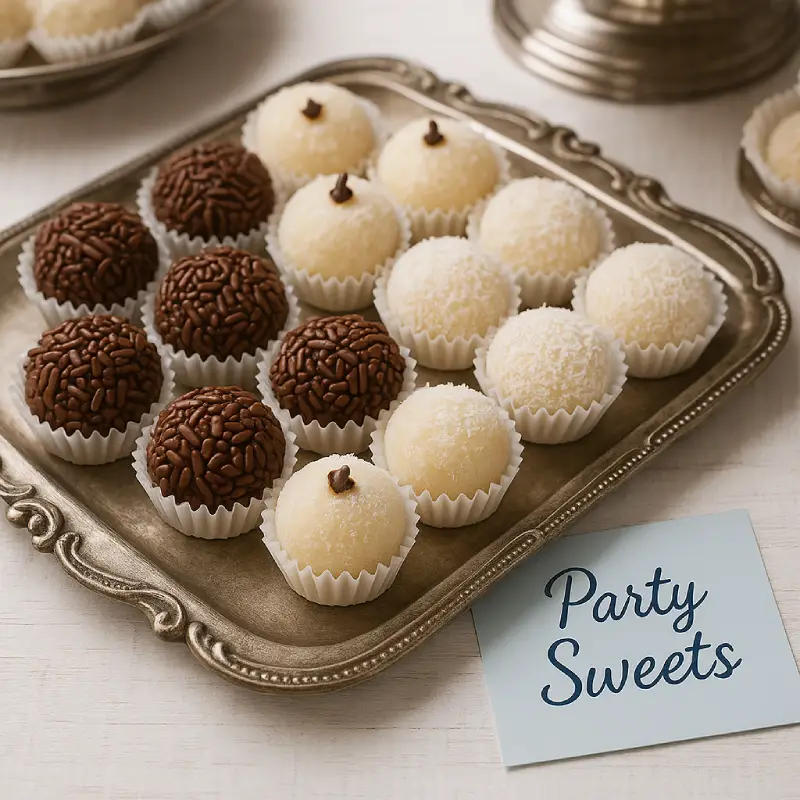Whether you’re planning a birthday, a wedding, or a casual family gathering, party sweets are an essential part of the celebration.
These little bites of joy are more than just treats—they’re cultural icons, nostalgic reminders of childhood, and guaranteed crowd-pleasers. From creamy brigadeiros to soft coconut balls, traditional sweets never go out of style.
In this guide, you’ll learn how to make classic party sweets from scratch, with step-by-step instructions, preparation tips, and creative ideas to serve them beautifully and efficiently.
Why Traditional Sweets Always Work
There’s a reason some sweets never leave the dessert table. Traditional party treats are:
-
Simple to make in large batches
-
Cost-effective and use basic ingredients
-
Easy to store and transport
-
Perfect for all ages and occasions
-
Customizable with flavors, colors, and decorations
In short, they combine comfort, nostalgia, and presentation—making them ideal for everything from birthday parties to corporate events.
The Three Most Popular Traditional Sweets
Let’s focus on three timeless favorites that are common in many cultures, especially in Latin American and Brazilian-style parties:
-
Brigadeiro (chocolate fudge ball)
-
Beijinho (coconut kiss)
-
Coconut condensed milk balls (no-cook sweet)
These sweets are rich, flavorful, and easy enough for beginners to master.
1. Brigadeiro: The Classic Chocolate Fudge Ball
Brigadeiro is a beloved Brazilian sweet that’s made with just a few ingredients but delivers intense flavor and creamy texture.
Ingredients:
-
1 can (395g) sweetened condensed milk
-
2 tablespoons unsweetened cocoa powder
-
1 tablespoon unsalted butter
-
Chocolate sprinkles for coating
Instructions:
-
In a non-stick pan, combine condensed milk, cocoa powder, and butter.
-
Cook over medium heat, stirring constantly with a wooden spoon or silicone spatula.
-
After about 10–12 minutes, the mixture will thicken and start pulling away from the pan.
-
Transfer to a greased plate or bowl and let it cool to room temperature.
-
Butter your hands and roll into small balls (about 15g each).
-
Roll in chocolate sprinkles and place in mini paper cups.
Variations:
-
Add a pinch of sea salt for contrast.
-
Use crushed nuts or chocolate shavings instead of sprinkles.
-
Flavor with a drop of espresso or orange essence for a twist.
2. Beijinho: Coconut Kisses with a Hint of Clove
Another staple in traditional parties, beijinho offers a delicate flavor and creamy consistency that contrasts nicely with chocolate treats.
Ingredients:
-
1 can (395g) sweetened condensed milk
-
1 tablespoon unsalted butter
-
100g shredded coconut
-
Cloves for decoration (optional)
-
Sugar or extra coconut for rolling
Instructions:
-
Combine the condensed milk, butter, and 70g of the shredded coconut in a saucepan.
-
Cook over low heat, stirring constantly, until the mixture pulls away from the bottom (about 10 minutes).
-
Cool the mixture, then butter your hands and shape into small balls.
-
Roll in remaining coconut or granulated sugar.
-
Optionally, top each sweet with a whole clove for presentation.
Tips:
-
These sweets have a creamy coconut flavor and pair well with tropical fruit decor.
-
Remove the cloves before serving to children.
3. No-Cook Coconut Balls: Fast and Delicious
When you need something quick and still delicious, this no-cook recipe saves time without compromising on taste.
Ingredients:
-
200g sweetened condensed milk
-
150g shredded coconut
-
½ teaspoon vanilla extract
-
More coconut or sugar for coating
Instructions:
-
In a mixing bowl, combine condensed milk, coconut, and vanilla.
-
Mix well until the texture is thick and moldable.
-
Roll into small balls, then coat with coconut flakes or sugar.
-
Chill in the fridge for at least 30 minutes before serving.
Presentation Ideas That Impress
It’s not just about taste—presentation matters too. Even simple sweets can feel elegant with the right styling.
Tips for Visual Impact:
-
Use colored or metallic mini paper cups.
-
Arrange sweets in neat rows on a tiered tray.
-
Decorate trays with flowers, fabric, or fruit slices.
-
Label each sweet with handwritten tags or small chalkboard signs.
-
Coordinate colors with the party theme.
For weddings and formal events, consider wrapping sweets in decorative boxes or gift-style packaging as edible favors.
Storage and Shelf Life
Traditional sweets are perfect for making ahead of time, but storage is key to maintaining freshness and texture.
-
Brigadeiros & Beijinhos: Store in airtight containers in the refrigerator for up to 5 days.
-
No-cook coconut balls: Best within 3 days.
-
Let sweets come to room temperature before serving for best texture.
-
Avoid stacking sweets without dividers to prevent sticking or flattening.
Make in Bulk Without the Stress
If you’re preparing sweets for a large event, follow these bulk preparation tips:
-
Use a digital scale to ensure consistency in size.
-
Prepare one base (like sweetened condensed milk + butter) and flavor in separate batches.
-
Create a production line: one station for rolling, one for coating, and one for packaging.
-
Recruit help if possible—rolling and coating are great team tasks.
Making 100+ sweets? Prepare and freeze the rolled but uncoated balls. Thaw and finish coating the day before the event.
Final Thoughts: A Sweet Tradition Worth Keeping
Traditional party sweets are more than just desserts—they’re shared memories, expressions of culture, and tokens of love. With a few ingredients and a little time, you can bring joy to any celebration, big or small.
Once you’ve mastered these classics, you’ll have a reliable menu for parties, gifts, or even starting a small sweets business. Whether served on a decorated table or packaged as favors, these treats never fail to impress.


Very good recipe, I made it and it turned out perfectly